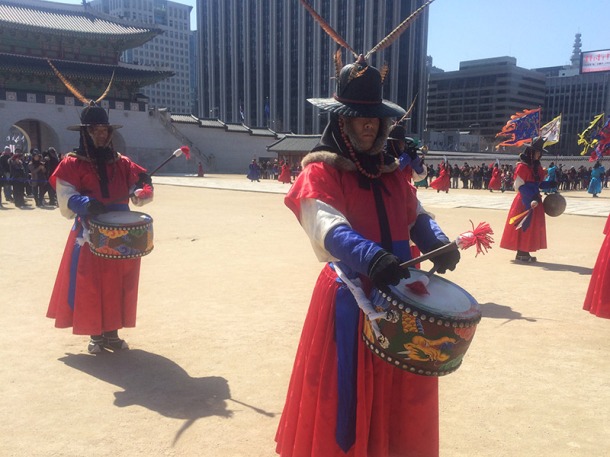This weekend, I went to Gyeongbokgung Palace which is located at the northern part of Seoul. Korean people are very proud of this palace as it is very grand with its uniquely impressive architecture styles.
First of all, I would like to tell you how to get there. If you are leaving from Hanyang University station, you have to transfer at Euljiro 3(sam)-ga station, and then from there, you can get directly to Gyeongbokgung station. You have to get off at this station.
I arrived there around 12:30, and there was a performance beginning at 1. The performance is just a display of Korean armies marching around the compound in front of the palace.
There is a free English tourist guide for the visitors every day at three different times, namely 11:00am, 1:30pm, and 3:30pm. Considering the low admission fee of 3,000 Won, getting a free English tour guide seems to be a very decent deal to me. So, I would recommend you to go around the palace with the tour guide. Also, because you can easily get lost on your own in this big palace.
In front of the palace, I was greeted by a mysteriously looking animal which Koreans call “Haechi”. There is no English name for it, but it represents justice in Korea. Korean people value this animal so much like Chinese people value the dragon.
First of all, let me introduce the surrounding areas of Gyeongbokgung Palace.
You will see the statue of King Sejong which is located in front of the Gwanghwamun Gate. It will take about five minutes to walk from there though. To my surprise, when I saw the statue, there is a basement beneath the statue through which we can enter to learn the history of this renowned Korean king. During his rule, many technological innovations happened, and King Sejong himself was a keen king encouraging the development of science.
Near his statue, there is another statue of Admiral Yisun who was a courageous navy general of Korea. He is very famous for his battle at Hansan island against Japanese army in which his army was outnumbered. The Korean army only had 56 ships whereas the Japanese army owned 133 ships. Despite this clear disadvantage, Admiral Yisun led the army to victory, and therefore was and is regarded as a hero among Koreans.
To see this victorious Battle of Hansan Island, you can watch it at the basement floor underneath the Admiral Yisun statue. It is free of charge.
Ok. Let’s go back to the palace.
As I began my first step into the palace, I was greeted by a giant hall which had a throne in the center of it, and the tour guide explained me that it was the place where the meeting was held between the king and his subordinates.
One unique feature in the palace is that there is a layer of net on the ceiling which is the original idea of Korean ancestors to prevent birds from building nests at the top of these buildings.
On the next picture, this is me in front of a pavilion of the palace. It is also the place where parties were held in the past.
And, this is the bedroom of ancient times. In the photo, you can see that doors are hung upheld unlike modern doors. One can see lots of Korean traditional ways inside this old palace.
Actually, the palace is larger than all these locations. When I went there, the queen’s mother bedroom and concubines’ rooms are still renovated. So, I do not have a chance to visit these places. Other than that, I went around the palace for about an hour together with the tour guide, and I could learn much of Korean history from this visit.
At the end of the tour, we could see the blue house which is the residence of the Korean president. It is about ten-minutes walking distance from the palace. According to feng-shui (a Chinese tradition about choosing the location of one’s house by geographical location), the Blue House is in a very auspicious location as it is surrounded by mountains which are considered as good signs in feng-shui.
So, why don’t you go and see for yourself this amazing Gyeongbokgung Palace?
By Zaw from Myanmar









[…] Tongin Market was originally made to cater to Japanese residents from while Korea was under Japanese rule. After the Korean war, the market expanded quickly to serve the boom in Korean population and remains a popular spot for both locals and foreigners, conveniently close to Gyeongbokgung Palace (경복궁역). […]